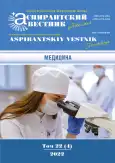Актуальные аспекты качественного и количественного анализа тысячелистника обыкновенного (Achillea Millefolium L.)
- Авторы: Васькова А.И.1, Куркин В.А.1
-
Учреждения:
- ФГБОУ ВО «Самарский государственный медицинский университет» Минздрава России
- Выпуск: Том 22, № 4 (2022)
- Страницы: 40-46
- Раздел: ФАРМАЦЕВТИЧЕСКАЯ ХИМИЯ, ФАРМАКОГНОЗИЯ
- URL: https://journal-vniispk.ru/2410-3764/article/view/120412
- DOI: https://doi.org/10.55531/2072-2354.2022.22.4.40-46
- ID: 120412
Цитировать
Полный текст
Аннотация
Цель – разработать методику качественного и количественного анализа флавоноидов в траве тысячелистника обыкновенного.
Материал и методы. Материалом исследования служила трава тысячелистника обыкновенного, заготовленная в 2020 и 2021 году, а также промышленный образец сырья АО «Красногорсклексредства». Кроме того, использовались стандартные образцы (СО) флавоноидов, полученные авторами в ходе предыдущих исследований ЛРС, содержащего флавоноиды, охарактеризованные с использованием ЯМР, УФ и масс-спектроскопии: рутин, кверцетин, кемпферол, цинарозид, лютеолин. Определение подлинности осуществляли методом тонкослойной хроматографии (качественный анализ). В качестве метода количественного определения суммы флавоноидов использована дифференциальная спектрофотометрия, проведенная в соответствии с ОФС.1.2.1.1.0003.15 «Спектрофотометрия в ультрафиолетовой и видимой областях». Спектральные характеристики водно-спиртовых извлечений оценивали на спектрофотометре Specord 40 (Analytik Jena AG, Германия) в кюветах с толщиной слоя 10 мм.
Результаты. Исходя из результатов определения подлинности, выявлены три зоны адсорбции, имеющие яркое желтое свечение в УФ-свете при длине волны 365 нм (реагент – AlCl3), одна из которых на уровне зоны адсорбции на хроматограмме раствора стандартного образца цинарозида с величиной Rf ≈ 0,7. Доминирующая зона адсорбции с величиной Rs 1,3 относительно СО цинарозида, предположительно, отнесена нами к космосиину, а зона адсорбции с величиной Rf ≈ 0,8 обнаружена на уровне СО кемпферола. Полученные данные подтверждают присутствие цинарозида в траве тысячелистника обыкновенного, а также возможность проведения качественного и количественного анализа травы данного сырья с использованием цинарозида в качестве стандартного образца. Также разработана методика количественного определения суммы флавоноидов в траве тысячелистника обыкновенного методом дифференциальной спектрофотометрии с использованием государственного стандартного образца цинарозида при аналитической длине волны 400 нм. Содержание суммы флавоноидов для травы тысячелистника обыкновенного варьирует от 0,41±0,02 % до 0,74±0,03 % (в пересчете на цинарозид). Ошибка единичного определения с доверительной вероятностью 95% составляет 6,70%.
Ключевые слова
Полный текст
Открыть статью на сайте журналаОб авторах
А. И. Васькова
ФГБОУ ВО «Самарский государственный медицинский университет» Минздрава России
Email: a.i.vaskova@samsmu.ru
ORCID iD: 0000-0002-6517-4816
аспирант кафедры фармакогнозии с ботаникой и основами фитотерапии
Россия, СамараВ. А. Куркин
ФГБОУ ВО «Самарский государственный медицинский университет» Минздрава России
Автор, ответственный за переписку.
Email: v.a.kurkin@samsmu.ru
ORCID iD: 0000-0002-7513-9352
д-р фарм. наук, заведующий кафедрой фармакогнозии с ботаникой и основами фитотерапии
Россия, СамараСписок литературы
- Maevskii PF. Flora of Middle Part of European Russia. M., 2014. (In Russ.). [Маевский П.Ф. Флора средней полосы европейской части России. М., 2014].
- Maznev NI. Encyclopedia of Medicinal Plants. М., 2004:407-408. (In Russ.). [Мазнев Н.И. Энциклопедия лекарственных растений. М., 2004:407-408].
- Pharmacopoeia оf the Russian Federation, XIV-ed. [Electronic resource]. (In Russ.). [Государственная фармакопея Российской Федерации XIV изд. [Электронное издание]. URL: https://femb.ru/record/pharmacopea14
- Vernikovskaya NA, Temerdashev ZA. Identification and chromatographic determination of phenolic compounds in yarrow. Analitika i kontrol’. 2012;2:188-195. (In Russ.). [Верниковская Н.А., Темердашев З.А. Идентификация и хроматографическое определение фенольных соединений в тысячелистнике обыкновенном. Аналитика и контроль. 2012;2:188-195].
- Komarov BA. The elemental composition of yarrow. Razrabotka i registraciâ lekarstvennyh sredstv. 2018;3:158-161. (In Russ.). [Комаров Б.А. Элементный состав тысячелистника обыкновенного. 2018;3:158-161].
- Kurkin VA. Pharmacognosy. Samara, 2020. (In Russ.). [Куркин В.А. Фармакогнозия. Самара, 2020].
- Shatalina NV, Pervishina GG, Efremov AA, et al. Content of some biologically active substances in common yarrow herb (Achillea millefolium) growing in Krasnoyarsk region. Khimiya Rastitel'nogo Syr'ya. 2002;3:13-16. (In Russ.). [Шаталина Н.В., Первышина Г.Г., Ефремов А.А., и др. Содержание некоторых биологически активных веществ в траве тысячелистника обыкновенного (Achillea millefolium), произрастающего в Красноярском крае. Химия растительного сырья. 2002;3:13-16].
- Aslanova D, Karomatov ID. Achillea millefolium in traditional and scientific medicine. Biologiya i integrativnaya meditsina. 2018;1(18):167-186. (In Russ.). [Асланова Д., Кароматов И.Д. Тысячелистник обыкновенный в народной и научной фитотерапии. Биология и интегративная медицина. 2018;1(18):167-186].
- Chusovitina KA, Karpuhin MYu. Pharmacological specificities of Yarrow (Achillea millefolium L.). Agrarnoe obrazovanie i nauka. 2019;4:31. (In Russ.). [Чусовитина К.А., Карпухин М.Ю. Фармакологические особенности тысячелистника обыкновенного (Achillea millefolium L.). Аграрное образование и наука. 2019;4:31].
- Lakshmi T, Geetha RV, Anitha R, et al. Yarrow (Achillea millefolium Linn.) A herbal medicinal plant with broad therapeutic use – A review. International Journal of Pharmaceutical Sciences Review and Research. 2011;9:136-141.
- Vardanyan LR, Atabekyan LV, Hayrapetyan SА, Vardanyan RL. Antioxidant activity of the ethyl acetate extract of different types of the thousand (Achillea L.). Khimiya Rastitel'nogo Syr'ya. 2018;3:61-68. (In Russ.). [Варданян Л.Р., Атабекян Л.В., Айрапетян С.А., Варданян Р.Л. Антиоксидантная активность этилацетатного экстракта разных видов тысячелистника (Achillea L.). Химия растительного сырья. 2018;3:61-68]. doi: 10.14258/jcprm.2018033697
- Tarun EI, Kuxta AN, Nebokatkina AA, Kurchenko VP. Antioxidant activity of extracts of milfoil flowers and leaves. Journal of the Belarusian State University. Ecology. 2022;3:57-65. (In Russ.). [Тарун Е.И., Кухта А.Н., Небокаткина А.А., Курченко В.П. Антиоксидантная активность экстрактов цветов и листьев тысячелистника. Журнал Белорусского государственного университета. Экология. 2022;3:57-65]. doi: 10.46646/SAKH-2020-2-174-177
- Ahmadi A, Ezzatpanah H, Asgary S. et al. Phytochemical, Antioxidant and Antimicrobial Activity of the Essential Oil from Flowers and Leaves of Achillea millefolium subsp. millefolium. Journal of Essential Oil Bearing Plants. 2017;20:395-409. doi: 10.1080/0972060X.2017.1280419
- Salehi B, Selamoglu Z, Sevindik M, et al. Achillea spp.: A comprehensive review on its ethnobotany, phytochemistry, phytopharmacology and industrial applications. Cellular and molecular biology. 2020;66(4):78-103. doi: 10.14715/cmb/2020.66.4.13
- Kurkina AV. Flavonoids of pharmacopoeial plants. Samara, 2012. (In Russ.). [Куркина А.В. Флавоноиды фармакопейных растений. Самара, 2012].
Дополнительные файлы













